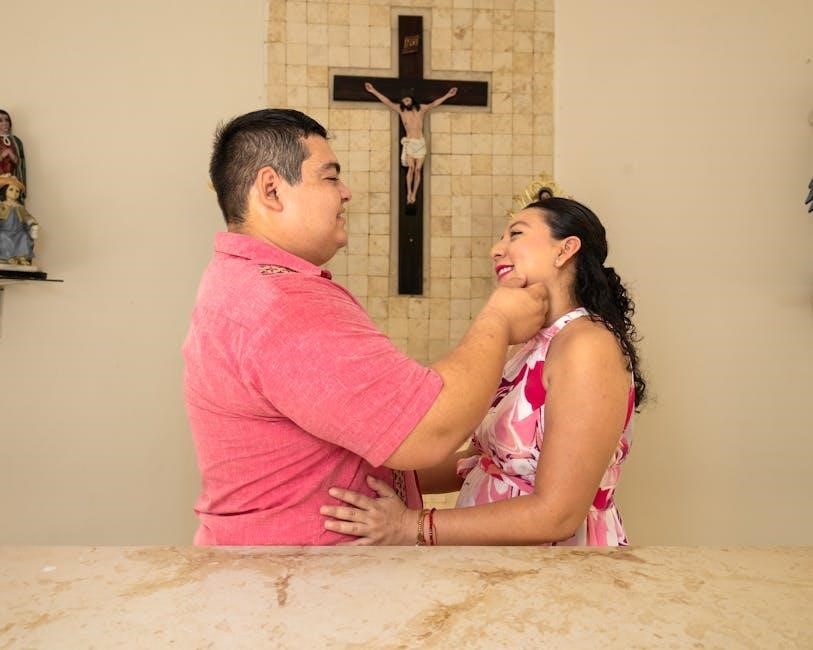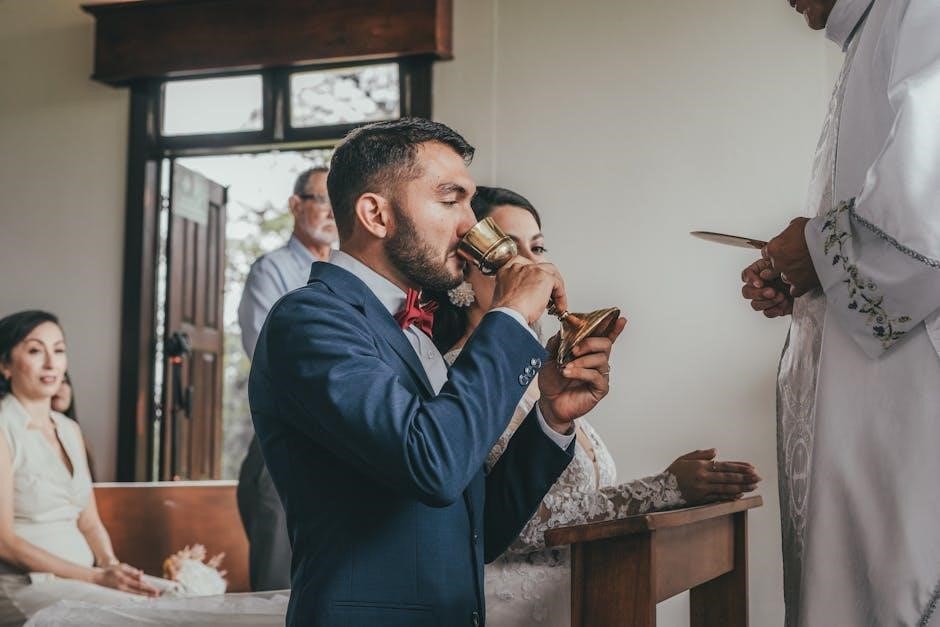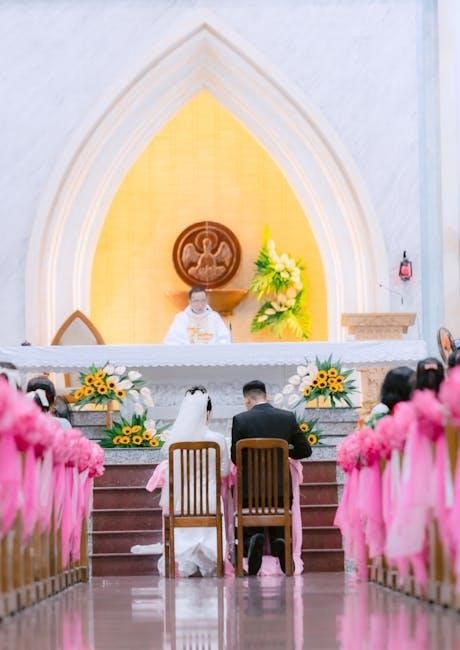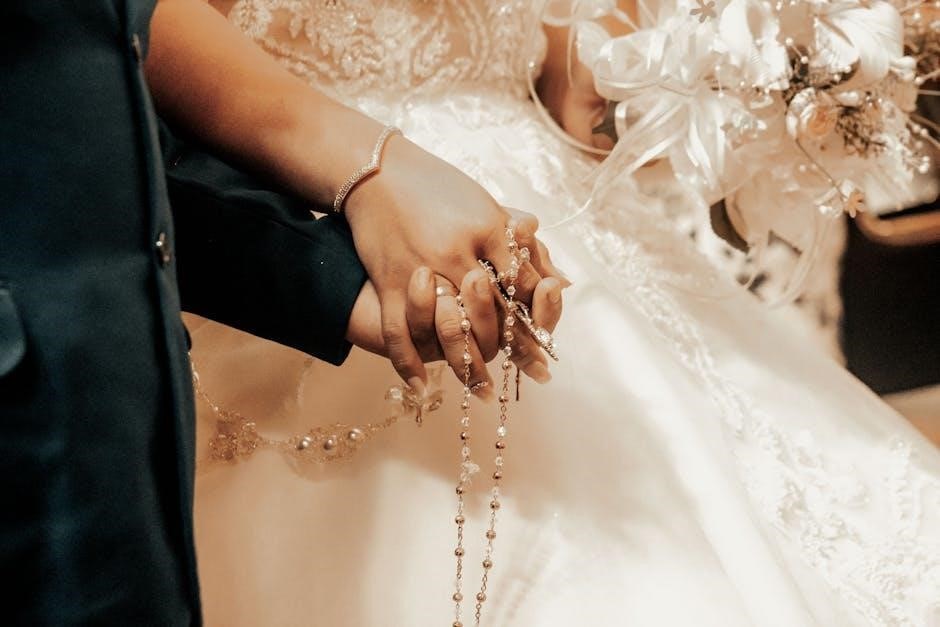The Catholic Rite of Marriage is a sacramental ceremony uniting two individuals in a lifelong commitment, emphasizing faith, mutual consent, and the exchange of vows and rings.
1;1. Overview of the Catholic Marriage Rite
The Catholic Marriage Rite is a sacred sacrament where two individuals commit to a lifelong union, guided by faith and mutual consent. Central to the rite is the exchange of vows and rings, symbolizing their enduring commitment. The ceremony typically begins with introductory rites, including a processional and welcoming prayers. The couple then expresses their consent, followed by the Liturgy of the Eucharist, which may include Communion. The rite emphasizes unity, love, and fidelity, reflecting the Church’s teachings on marriage as a divine institution. This sacrament is celebrated within the context of the Mass, underscoring its spiritual significance.
1.2. Importance of the Sacrament in the Catholic Church
The Sacrament of Marriage holds profound significance in the Catholic Church, symbolizing God’s union with His people and Christ’s love for the Church. It is seen as a divine institution, a covenant between two individuals that mirrors divine love and fidelity. Marriage is not merely a social contract but a sacred bond that reflects the Church’s teachings on family and life. Through this sacrament, couples are called to live out their faith, fostering holiness and mutual support. The Church views marriage as essential for the transmission of faith and the formation of Christian families, contributing to the broader mission of the Church.

The Rite of Marriage Ceremony Structure
The ceremony consists of Introductory Rites, the Rite of Marriage itself, and the Liturgy of the Eucharist, following a structured flow to solemnize the union sacramentally.
2.1. Introductory Rites
The Introductory Rites initiate the ceremony, setting a sacred tone. The processional begins with the wedding party entering the church, followed by the bride escorted by her father. The priest greets the couple at the altar, welcoming them and invoking divine grace. ThePenitential Rite, optional but common, includes a prayer for forgiveness and reconciliation. The priest then offers an opening prayer, invoking God’s blessings on the couple. This segment establishes the liturgical context, preparing all present to witness and celebrate the sacrament. The Introductory Rites conclude with an invitation to worship, transitioning into the Liturgy of the Word.
2.2. The Rite of Marriage Itself
The Rite of Marriage begins with the priest addressing the couple, emphasizing the sacred nature of their commitment. The couple is asked to declare their intention to marry, followed by the exchange of vows and rings. The priest then offers a nuptial blessing, invoking divine grace upon the union. This rite is deeply rooted in Catholic tradition, symbolizing the couple’s lifelong dedication to one another. The ceremony concludes with a prayer for the newlyweds, asking for God’s continued guidance and protection in their shared life. This rite is the heart of the marriage celebration, formally establishing the sacramental bond between the couple.
2.3. Liturgy of the Eucharist
The Liturgy of the Eucharist is the climax of the Catholic marriage rite, where the couple and assembly participate in the Mass. The priest offers prayers and readings, followed by the Offertory, Consecration, and Communion. The couple receives the Eucharist, symbolizing their union with Christ and each other. This liturgy reinforces the sacramental nature of marriage, with the Mass formulary for marriage used on permitted days. The Eucharist nourishes the couple spiritually, strengthening their commitment to a lifelong, faith-centered relationship. The prayers and readings emphasize fidelity, mutual support, and the divine grace sustaining their marital bond.
Key Elements of the Rite
The Catholic Rite of Marriage includes the exchange of consent, vows, and rings, followed by the Liturgy of the Eucharist, emphasizing the sacramental union and divine grace.
3.1. The Exchange of Consent and Vows
The exchange of consent and vows is the heart of the Catholic Rite of Marriage, where the couple publicly declares their commitment before God and the Church. This moment is deeply sacramental, as their mutual consent establishes the bond of marriage. The vows, often phrased as promises to love and cherish one another, reflect the sacrament’s indissoluble nature. The priest witnesses this exchange, emphasizing the sacredness of the union. This rite is a profound expression of faith, free will, and the couple’s readiness to embrace a lifelong partnership rooted in love and fidelity, mirroring Christ’s love for his Church.

3.2. The Blessing and Exchange of Rings
The blessing and exchange of rings is a sacred moment in the Catholic Rite of Marriage, symbolizing the couple’s eternal commitment and unity. The priest invokes God’s blessing upon the rings, asking for divine grace to strengthen the union. The rings, often inscribed with meaningful phrases, signify the couple’s mutual ownership and fidelity. As they exchange the rings, the couple pledges to honor and cherish one another, echoing the vows they have just declared. This ritual reinforces the sacramental bond, serving as a visible reminder of their lifelong covenant before God and the Church. The rite underscores the enduring nature of marital love and commitment.
3.3. The Nuptial Mass and Communion
The Nuptial Mass is a profound liturgical celebration within the Catholic Rite of Marriage, where the Eucharist is central. It begins with the Introductory Rites, followed by the Liturgy of the Word, which includes readings and a homily. The couple’s union is then consecrated through the Eucharistic Prayer. The newlyweds, along with their guests, receive Holy Communion, symbolizing their unity in Christ. This sacrament strengthens their bond, renewing their commitment to love and serve one another. The Nuptial Mass culminates in the Final Blessing, invoking divine grace upon the couple as they embark on their marital journey, rooted in faith and sacramental grace.

Regulations and Requirements
Catholic marriage requires canonical consent, proper documentation, and witnesses. Couples must meet specific conditions, ensuring freedom, capacity, and adherence to Church laws governing valid matrimony.

4.1. Canonical Requirements for a Valid Catholic Marriage
A valid Catholic marriage requires the free and mutual consent of both parties, expressed in the presence of an authorized priest or deacon and two witnesses. Both individuals must be baptized, with at least one being Catholic. The Church mandates that couples adhere to canonical age requirements, typically 18 for men and 16 for women, unless dispensations are granted. Additionally, they must not be bound by prior marriages or impediments such as consanguinity or affinity. Documentation, including baptismal certificates and pre-marriage counseling, is essential. The ceremony must follow the prescribed liturgical rite, ensuring the sacrament’s validity and alignment with Church teachings.
4.2. Forbidden Times and Days for the Ceremony
The Catholic Church prohibits the celebration of marriage during certain penitential periods, such as Lent and Advent, unless a dispensation is granted. Sundays during Lent are particularly avoided, as they are dedicated to preparation for Easter. Additionally, marriages are not typically scheduled on major feast days like Christmas or Easter, as these days are reserved for liturgical celebrations. The Church also discourages weddings during the Paschal Triduum (Holy Thursday to Easter Sunday) due to its solemn nature. Couples may need to seek special permission if they wish to marry during these times, ensuring the ceremony aligns with the liturgical calendar and the Church’s spiritual focus.
Cultural and Liturgical Variations

Cultural and liturgical variations enrich the Catholic marriage rite, incorporating local traditions while maintaining sacramental integrity, reflecting the universal Church’s diverse expressions of faith and celebration.

5.1. Incorporation of Local Traditions
The Catholic Rite of Marriage often incorporates local traditions, enriching the ceremony while maintaining its sacramental integrity. For instance, the veiling rite in the Mozarabic liturgy reflects cultural and liturgical diversity. Many cultures integrate unique prayers, chants, or symbolic gestures, such as the exchange of arras coins in Hispanic traditions; These customs are approved by the Church to deepen the couple’s connection to their heritage. By blending universal Catholic teachings with regional practices, the rite becomes a vibrant expression of faith, fostering unity in diversity. This approach ensures the sacrament remains meaningful across different cultures and historical contexts.
5;2. The Veiling Rite in the Mozarabic Liturgy
The veiling rite in the Mozarabic liturgy is a unique tradition within the Catholic Rite of Marriage, symbolizing unity and protection. During this rite, a single veil covers both the bride and groom, signifying their shared commitment and divine safeguarding; Rooted in ancient Spanish liturgical practices, this ritual emphasizes the couple’s mutual submission to God and each other. The veil serves as a visual reminder of their sacred bond, blending cultural heritage with theological significance. This distinctive practice highlights the richness of liturgical diversity within the Catholic Church, offering a profound expression of marital devotion and spiritual unity. It remains a cherished tradition in Mozarabic communities.

Concluding Rites
The concluding rites include the final blessing and dismissal, marking the end of the ceremony. The recessional follows, symbolizing the couple’s new life together.

6.1. Final Blessing and Dismissal
The final blessing is a solemn invocation of God’s grace upon the newlyweds, seeking divine guidance and protection. The dismissal concludes the ceremony, sending the couple forth to begin their married life. This moment is significant as it formally ends the liturgical celebration and commissions the couple to live out their vows in the world. The priest’s words of blessing and dismissal are a powerful sendoff, reminding the couple of God’s enduring presence in their union.
6.2. The Recessional
The recessional marks the joyous conclusion of the marriage ceremony, as the newlyweds lead the procession out of the church. Accompanied by music, the couple exits, symbolizing their union and new life together. The recessional is a moment of celebration, with the bride and groom often greeted by applause or cheers. This final procession signifies the end of the liturgical rite and the beginning of their journey as a married couple. The couple is presented to the assembly as husband and wife, embodying the unity and commitment they have just solemnized. The recessional is a hopeful and festive moment, filled with joy and anticipation for the future.